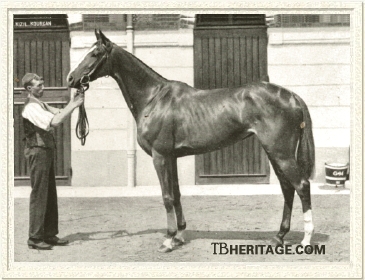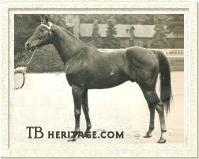|
|
Kizil Kourgan

|
|
 |
|
|
Thoroughbred history records the English mare Sceptre as one of the greatest racemares of all time. Her zenith was reached during her classic season of 1902, when she swept four classics. Across the channel, in the same year, there was another brilliant and equally dominant three-year-old filly, and when the two met on the racecourse, it was "Vive la France," as the victress was Kizil Kourgan, to this day considered one of France's greatest race mares.
Kizil Kourgan was foaled in 1899. She was bred by Evremond de Saint-Alary at his Haras de Saint-Pair du Mont near Calvados, in France's Normandy region. Saint-Alary was by birth an Englishman. Born in 1868, Saint-Alary in his twenties inherited the title of Count and a sizable inheritance. Keen to breed racehorses, he purchased Haras de Saint-Pair du Mont, and in 1893, at the age of 25, he purchased a yearling colt by Upas at the Deauville sales. Named Omnium, he would soon reap rewards for his young owner.
Omnium descended in the male line from The Flying Dutchman, the English Derby winner who had been exported to France in the 1850s and proceeded to become an influential sire in his new homeland, most notably through his son Dollar. Foaled in 1860, Dollar was a docile horse with a generous compliment of stamina. His numerous victories included the Grand Prix de l'Empereur in France and the Goodwood Cup in England.
Dollar sired Upas, winner in a dead-heat with Sycomore of the Prix du Jockey Club. Upas proved a reliable sire of stayers, his most notable being Omnium. As a three-year-old, Omnium emerged not only as a classic winner and the best colt of his generation, but a stayer of the highest quality, taking laurels in the Prix du Jockey Club, Prix Lagrange, and Prix du Conseil Municipal. At four, he took the Prix Boïard, a second edition of the Prix du Conseil Municipal, as well as the Prix Gladiateur, a race run over a marathon distance of just over three miles. Retired to Haras de Saint-Clair du Mont, he, like his sire, Upas, and grandsire, Dollar before him, became a strong influence for stamina.
One of the mares brought to Omnium in the spring of 1898 was Kasbah. Saint-Alary purchased her expressly as a mate for Omnium, and paid the high sum of 30,000 francs for her. Saint-Alary felt she was well worth the price, as she had both a splendid pedigree and a fine racing record to match. On the racecourse, Kasbah boasted a victory in the Prix de Diane. She was also second in the Poule d'Essai des Pouliches.
Kasbah's sire, Vigilant, had victories in the Grand Critérium and Grand Prix de Produits on his resume, and her grandsire, Vermout, had won the Grand Prix de Paris and Grosser Preis von Baden-Baden. Kasbah's dam, Katia, was by Guy Dayrell, winner of the Lincolnshire Handicap and a son of English Derby winner Wild Dayrell. Kasbah's second dam was by France's hero, Gladiateur, revered by the French and reviled by some English for his display of utter superiority in sweeping through the English Triple Crown in 1865. What made her such a tremendous broodmare prospect was the fact she counted Pocahontas as her fifth dam. This was not only the female family of Stockwell, King Tom, and Rataplan, but of English classic champions Camelia, Chamant, and Rayon d'Or, as well.
As a broodmare for Saint-Alary, Kasbah produced several daughters, the best being Kizil Kourgan. The other daughters of Kasbah were of little account in training and did not immediately prove their worth when retired for breeding, but came up with some important descendants. Kizil Sou, a full sister to Kizil Kourgan foaled in 1900, became the second dam of Kantar, winner at two of the Grand Critérium and Prix Morny and at three of the Prix de l'Arc de Triomphe. Kizil Koum, a half-sister to Kizil Kourgan by Delaunay, became the second dam of Kiss Curl, on the track the winner of the Prix Chantilly and Prix Dollar and at stud, ancestress of Oaks d'Italia victress Kerkenna and Puerto Rican champions Missed Out and Alra.
Kizil Kourgan on the Turf
Kizil Kourgan, a racy, muscular chestnut filly with a blaze and three white feet, excelled in her training from the start. Promising in her racecourse appearances as a juvenile, Kizil Kourgan proved a typical specimen of her sire line, she reached the full potential of her powers on the racetrack as a three-year-old. She was dominant and versatile, winning from one mile to 1-7/8 miles, beating colts as easily as she did her female contemporaries. She began her season by taking the one mile Poule d'Essai des Pouliches, then the Prix Lupin over colts. This proved an appetizer for her growing legion of fans, as in her next start, she easily captured the Prix de Diane.
She took dead aim on the Grand Prix de Paris, where she would not only meet the best of France, but foreign invaders, as well. One of the foreigners set to compete against her was the fabulous English filly Sceptre.
Sceptre was the best three-year-old of either sex in Britain that season of 1902. She was a daughter of the Prince of Wales's Derby and St. Leger champion Persimmon out of Ornament, a full sister to Triple Crown winner Ormonde. Bred by the first Duke of Westminster, she came up for sale as a yearling in 1900 at the dispersal of the recently-deceased Duke's bloodstock holdings. She was purchased for the enormous sum of 10,000 guineas by racing journalist and gambler Robert Sievier. Early in her three-year-old season, Sievier took over training of Sceptre himself, and it was a testament to the courage and stamina of this wonderful filly that she survived his unorthodox training methods to capture the One Thousand and Two Thousand Guineas and the Oaks, as well as running a gallant fourth to Ard Patrick in the Derby.
The English were supremely confident their national heroine would show her heels to the assembled field for the Grand Prix, including the razor sharp Kizil Kourgan. The French were just as confident in their filly. In the race itself, Sceptre raced very wide, her jockey overcome with a sense of caution at the French reputation for being less than courteous to foreign entrants in the running of races. Nevertheless, Sceptre still managed to finish second as Kizil Kourgan kept a straight and true course and crossed the finish well ahead of her courageous English contemporary.
The two fillies never met again. Sceptre went back across the Channel, and that autumn, landed her fourth classic race of the season when she took the St. Leger. Kizil Kourgan took the French version of the St. Leger, the Prix Royal-Oak. In the classic tally, Kizil Kourgan totaled three to Sceptre's four. Kizil Kourgan closed out her season with a surprise defeat, her grueling campaign probably finally having caught up with her. Saint-Alary was eager to retire her, anxious for her to prove herself as great in the breeding shed as she had been on the racecourse.
Kizil Kourgan as a Broodmare
The stud career of Kizil Kourgan proved to be one of mixed blessings. She produced very few live foals, which was a disappointment. Yet, despite her spotty record, she produced a colt who was nearly her equal on the racetrack.
Her 1905 colt, KENILWORTH, by Childwick, was a good stakes winner, though just a few notches below classic caliber. He captured the Prix Greffulhe and Prix Rainbow and was third in the Prix du Jockey Club. He spent the bulk of his stud career in Australia, where he became a decent sire, his most notable get being Rosehill Guineas winner Wolaroi.
KIAO TCHAU, Kizil Kourgan's 1914 filly by Chouberski, made no mark as a racetrack performer, but at stud produced English One Thousand Guineas winner Kandy, in turn the dam of Kipling, winner in South Africa of the Durban July Handicap and later a sire for that country. Kiao Tchau was second dam of Kraya, victress in the Prix la Rochette and ancestress of Prix Royal-Oak victor Denel. Kiao Tchau was significant for American racing as the fourth dam of Assagai, champion turf horse of 1966.
KIRIN, a year younger full sister to Kiao Tchau, was, like her elder sister, unable to make a name for herself on the track. As a broodmare, she produced Kitty, victorious in 1926 of the Belgian Triple Crown.
On the surface, this is the record of an average broodmare, and in the spring of 1917, when Saint-Alary had Kizil Kourgan covered by his Prix Royal-Oak and Grand Prix de Paris champion Brûleur, he may not have been expecting much. Kizil Kourgan had produced only one horse of any significance, and she was getting on in age. Her best productive years were seemingly behind her. In the spring of 1918, at the age of nineteen, Kizil Kourgan foaled a delicate chestnut colt.
|

Kzar
| |
Described as "awkwardly put together with large clodhopper feet and poor action," KSAR, as the colt was named, was not an impressive individual as a young colt. Saint-Alary decided to part with him, and catalogued him in the Deauville yearling sale. The colt, despite his faults, caught the eye of another pillar of French breeding, Edmond Blanc, and became Blanc's property on a final bid of 151,000 francs. Sadly, Blanc died soon after, and the colt raced for his widow. But Ksar justified Blanc's faith in him, taking the important Prix de la Salamandre at two, the Prix du Jockey Club, Prix Royal-Oak, and Prix de l'Arc de Triomphe at three, and the Prix du Cadran and a second Arc de Triomphe at four.
|
As a stallion at Madame Blanc's Haras de Jardy, KSAR became both a successful and influential sire. He led the French sire list in 1931. He sired classic winners Ukrania, Le Ksar, Thor, and Tourbillon.
Tourbillon became one of France's most important sires, coming up with five classic winners, and a major sire of sires, most notably through two of his sons, Djebel, a major sire in France and Britain, and Ambiorix, exported to Claiborne Farm in Kentucky, where he became the sire of many high class stakes winners.
It took a long time for Kizil Kourgan to prove her true worth as a broodmare. But when she did, she did so with authority, her son Ksar establishing a male line of his own which dominated French breeding and racing for decades.
--Elizabeth Martiniak
|
|
|
|

